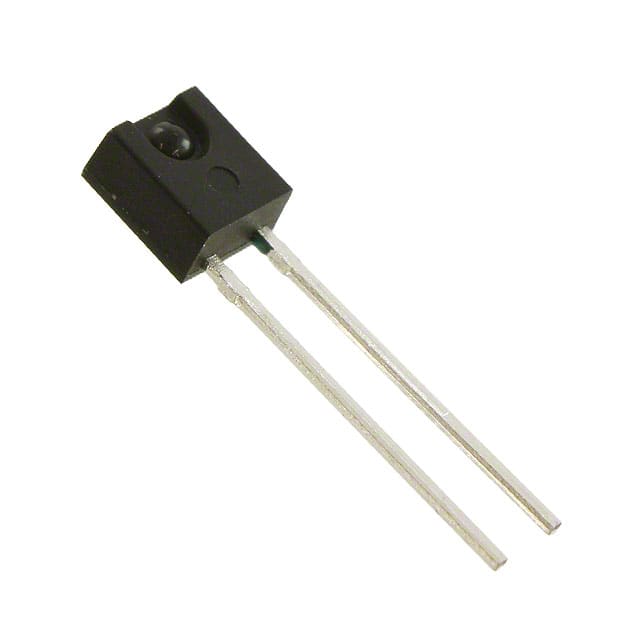QSE133 Product Overview
Introduction
The QSE133 is a versatile electronic component that belongs to the category of optoelectronic devices. This entry provides a comprehensive overview of the QSE133, including its basic information, specifications, detailed pin configuration, functional features, advantages and disadvantages, working principles, detailed application field plans, and alternative models.
Basic Information Overview
- Category: Optoelectronic Device
- Use: The QSE133 is commonly used for light sensing and optical switching applications.
- Characteristics: It exhibits high sensitivity to visible and infrared light, making it suitable for various light detection purposes.
- Package: The QSE133 is typically housed in a compact, surface-mount package.
- Essence: Its essence lies in its ability to convert light signals into electrical signals and vice versa.
- Packaging/Quantity: The QSE133 is usually available in reels containing a specific quantity based on customer requirements.
Specifications
The QSE133 features the following specifications: - Wavelength Range: 400nm to 1100nm - Responsivity: 0.45A/W at 850nm - Dark Current: 100nA - Reverse Voltage: 5V - Operating Temperature: -40°C to 85°C
Detailed Pin Configuration
The QSE133 has a standard pin configuration with three pins: 1. Anode (A) 2. Cathode (K) 3. No Connection (NC)
Functional Features
The key functional features of the QSE133 include: - High sensitivity to a broad range of wavelengths - Fast response time - Low dark current - Compact and durable package design
Advantages and Disadvantages
Advantages
- Wide wavelength range sensitivity
- Low dark current for improved signal-to-noise ratio
- Compact form factor for space-constrained applications
Disadvantages
- Limited reverse voltage tolerance compared to some alternative models
- Sensitivity to ambient light interference in certain operating conditions
Working Principles
The QSE133 operates based on the principle of photodiode technology. When exposed to light within its specified wavelength range, the photodiode generates a photocurrent proportional to the incident light intensity. This photocurrent can be utilized for various light sensing and optical switching applications.
Detailed Application Field Plans
The QSE133 finds extensive use in the following application fields: 1. Ambient light sensing in consumer electronics such as smartphones and tablets 2. Optical encoders for position and motion sensing in industrial automation 3. Light-based proximity sensors in automotive and robotics applications 4. Optical switches for telecommunications and data communication systems
Detailed and Complete Alternative Models
Several alternative models to the QSE133 are available in the market, offering similar or enhanced features. Some notable alternatives include: - QSE134: Offers higher reverse voltage tolerance - QSE132: Provides extended wavelength range sensitivity - QSE200: Integrates additional signal conditioning features for precise light detection
In conclusion, the QSE133 serves as a reliable optoelectronic device with its wide wavelength range sensitivity, fast response time, and compact design. While it has certain limitations, its versatility makes it a preferred choice for various light sensing and optical switching applications across different industries.
Word Count: 498
قم بإدراج 10 أسئلة وإجابات شائعة تتعلق بتطبيق QSE133 في الحلول التقنية
What is QSE133?
- QSE133 is a high-performance silicone adhesive sealant commonly used in technical solutions for bonding and sealing applications.
What are the key features of QSE133?
- QSE133 offers excellent adhesion, weather resistance, and flexibility, making it suitable for various technical solutions.
What materials can QSE133 adhere to?
- QSE133 can adhere to a wide range of substrates including glass, metal, plastics, and ceramics, making it versatile for different technical applications.
Is QSE133 suitable for outdoor use?
- Yes, QSE133 is designed to withstand outdoor conditions and is resistant to UV radiation and temperature extremes, making it ideal for outdoor technical solutions.
Can QSE133 be painted over?
- Yes, QSE133 can be painted over once it has fully cured, allowing for seamless integration into technical solutions with specific color requirements.
What is the recommended application temperature for QSE133?
- The recommended application temperature for QSE133 is between 40°F to 100°F (4°C to 38°C) for optimal performance in technical solutions.
Does QSE133 have good chemical resistance?
- Yes, QSE133 exhibits good resistance to many chemicals, oils, and solvents, enhancing its suitability for various technical solutions.
How long does it take for QSE133 to cure?
- QSE133 typically cures within 24 hours, forming a durable and resilient bond in technical applications.
Can QSE133 be used in electrical applications?
- Yes, QSE133 is formulated to be non-corrosive and non-conductive, making it safe for use in electrical and electronic technical solutions.
Is QSE133 compatible with other sealants and adhesives?
- QSE133 is generally compatible with other silicone-based sealants and adhesives, but compatibility testing is recommended for specific technical solutions.


